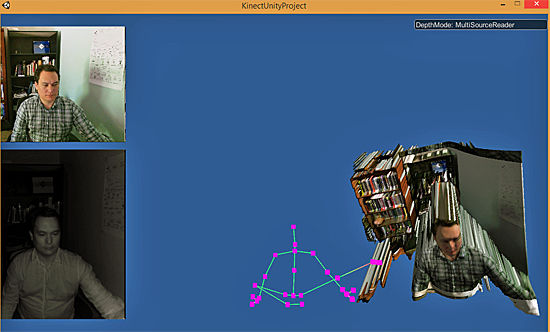Creating Kinect-enabled apps with Unity 5
So many blogs, so little time. Ever feel that way when you realize it’s been a long time since you’ve checked in with one of your favorite bloggers? Well, that’s how we’re feeling today, after reading this four-month old blog post from Microsoft Most Valuable Professional (MVP) James Ashley. It seems that while we were busy watching demos of Microsoft HoloLens and wondering what’s next for Cortana, Ashley was busy sussing out the possibilities for using the Kinect for Xbox One sensor (along with the Kinect Adapter for Windows) with the March 2015 release of Unity 5.

Kinect MVP James Ashley captures himself in a Kinect-enabled Unity 5 app.
With his usual attention to detail, Ashley takes the reader through nine steps to build a Kinect-enabled application in Unity 5 by using plug-in support available in Unity’s free Personal Edition. As he explains, this plug-in makes it “very easy to start building otherwise complex experiences like point cloud simulations that would otherwise require a decent knowledge of C++.”
Unity has long been the preferred platform for game developers, but until now, plug-in support was only available to those who purchased a costly Unity Pro license. With such support now included with the free Unity Personal license, there’s no cost barrier to creating Kinect-enabled Unity apps.
Let the games begin!
The Kinect for Windows Team
Key links
- Learn more about Kinect for Windows
- James Ashley's blog post from March 2015
- Explore more of James Ashley’s blog
- Download Unity 5
- Follow us on Facebook and Twitter
Comments
- Anonymous
January 05, 2016
The comment has been removed- Anonymous
January 27, 2016
Thank you for your interest. Please direct this technical question to our public Kinect for Windows v2 SDK forum, where you can exchange ideas with the Kinect community and Microsoft engineers. In the forum, you can also browse existing questions or ask a new question by clicking the Ask a question button. Access the forum at https://social.msdn.microsoft.com/Forums/en-US/home?forum=kinectv2sdk&filter=alltypes&sort=lastpostdesc. There is a discussion in the forum about troubleshooting avateering. You can link directly to that discussion at https://social.msdn.microsoft.com/Forums/en-US/e775e8bc-f9dc-485c-a6d3-47fd389947b8/kinect-avateering-problems?forum=kinectv2sdk.
- Anonymous